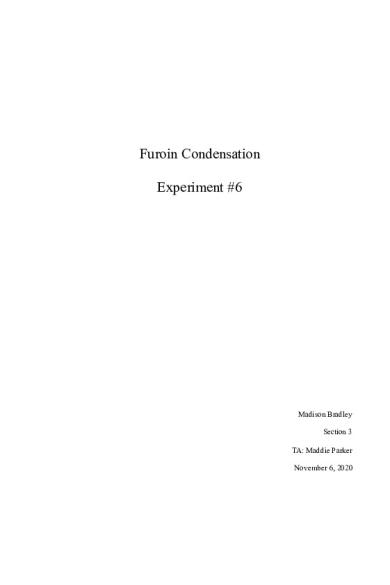Furoin Lab Report PDF

| Title | Furoin Lab Report |
|---|---|
| Author | Madison Bradley |
| Course | Organic Chemistry Laboratory |
| Institution | University of Iowa |
| Pages | 10 |
| File Size | 446.4 KB |
| File Type | |
| Total Downloads | 73 |
| Total Views | 181 |
Summary
Report from furoin condensation lab...
Description
Furoin Condensation Experiment #6
Madison Bradley Section 3 TA: Maddie Parker November 6, 2020
Results and Discussion: The purpose of the first part of the experiment was to convert the xylan in corn cobs to furfural. Based on the IR spectrum of the product (Appendix B), this was successful. The only functional groups present in furfural that are identifiable by IR are aldehyde (C=O and C-H) and sp2-hybridized carbons (C-H); these peaks were all present on the spectra. Although no additional data was collected on furfural, the absence of other functional groups on the spectra indicated that the product was pure. The purpose of the second part of the experiment was to convert furfural into furoin. Based on the IR spectrum of the product (Appendix B), this was successful. The only functional groups present in furoin that are identifiable by IR are carbonyl, alcohol, and sp2-hybridized carbons; these were all present on the spectrum. Since the alcohol did not have the traditional broad appearance of O-H stretches, the spectra was compared to a literature spectra published by Hanhong Group, a chemical supplier; both spectra were very similar, further supporting the conclusion that furoin was produced. The recorded melting point of furoin was 129-130C, which is a narrow range, and close to the literature value (obtained in the pre-lab assignment) of 138139C . The melting point and the lack of additional functional groups on the IR spectra indicated that this product was also pure. The yield of the first part of the experiment was 9.8% (Appendix A). After a while, the distillation process started to slow down. The apparatus was adjusted in hopes that gravity would help move things along, but this only did so much. Less than 15 mL of product had been collected when the TA instructed us to move on so that we would not run out of time. The lab manual recommended collecting 20 mL or more of product, so this is a potential reason for the low yield. The yield for the second part of the experiment was 5.4% crude and 4.4% recrystallized (Appendix A). Several issues that occurred during the vacuum filtration process that were likely the reasons for the low yield. During the first vacuum filtration attempt, the filter paper moved and much solid passed through into the filtrate. During the second attempt (using the first attempt’s filtrate), some of it was spilled while pouring. Additionally, a notable amount of solid stuck to the walls of each container it was in, and could not be transferred into the next container. The recrystallization process of furoin was successful, as the product was pure, and a high yield was recovered.
Appendix A
Percent yield of furfural: 1.47 g furfural ×100=9.8 % 15 g corncobs
Theoretical yield of furoin: 0.84 g furfural ×
1 mol furfural 1 mol furoin 192.17 g furoin × × =1.68 g 96.085 g furfural 1mol furfural 1mol furoin
Percent yield of crude furoin: 0.09 g furoin =.054=5.4 % 1.68 g furoin
Percent yield of recrystallized furoin: 0.074 g furoin =.044=4.4 % 1.68 g furoin
Appendix B
Furfural IR spectroscopy:
Wavenumbers 3100 cm-1 2950 cm-1 1700 cm-1
Bond =C-H H-C=O H-C=O
Functional Group Alkene Aldehyde Aldehyde
Furoin IR spectroscopy:
Wavenumbers 3405 cm-1 3127 cm-1 1674 cm-1
Bond O-H =C-H C=0
Functional Group Alcohol Alkene Carbonyl
Furoin H-NMR spectroscopy (from course website):
Proton A B C D E F G H
Shift 4.2 ppm 5.8 ppm 6.3 ppm 6.4 ppm 6.6 ppm 7.2 ppm 7.4 ppm 7.6 ppm
Integration 1 1 1 1 1 1 1 1
Splitting Singlet Singlet Triplet Doublet Doublet Triplet Doublet Doublet
Appendix C
Appendix D...
Similar Free PDFs

Furoin Lab Report
- 10 Pages

LAB 5 - Lab report
- 4 Pages

Lab 8 - lab report
- 6 Pages

TLC Lab Lab Report
- 4 Pages

Lemonade Lab - Lab report
- 4 Pages

Post Lab - lab report
- 2 Pages

TLC lab - Lab report
- 3 Pages

Lab 8 - lab report
- 3 Pages

Lab 6 - Lab Report
- 6 Pages

Lab Report 5 - lab
- 5 Pages

Planaria lab - lab report
- 6 Pages

Acceleration lab - lab report
- 3 Pages

Lab 1 - lab report
- 3 Pages

Enthalpy lab report - Lab
- 4 Pages

Lab Report 9 - lab
- 6 Pages

LAB MIC281 - lab report
- 12 Pages
Popular Institutions
- Tinajero National High School - Annex
- Politeknik Caltex Riau
- Yokohama City University
- SGT University
- University of Al-Qadisiyah
- Divine Word College of Vigan
- Techniek College Rotterdam
- Universidade de Santiago
- Universiti Teknologi MARA Cawangan Johor Kampus Pasir Gudang
- Poltekkes Kemenkes Yogyakarta
- Baguio City National High School
- Colegio san marcos
- preparatoria uno
- Centro de Bachillerato Tecnológico Industrial y de Servicios No. 107
- Dalian Maritime University
- Quang Trung Secondary School
- Colegio Tecnológico en Informática
- Corporación Regional de Educación Superior
- Grupo CEDVA
- Dar Al Uloom University
- Centro de Estudios Preuniversitarios de la Universidad Nacional de Ingeniería
- 上智大学
- Aakash International School, Nuna Majara
- San Felipe Neri Catholic School
- Kang Chiao International School - New Taipei City
- Misamis Occidental National High School
- Institución Educativa Escuela Normal Juan Ladrilleros
- Kolehiyo ng Pantukan
- Batanes State College
- Instituto Continental
- Sekolah Menengah Kejuruan Kesehatan Kaltara (Tarakan)
- Colegio de La Inmaculada Concepcion - Cebu